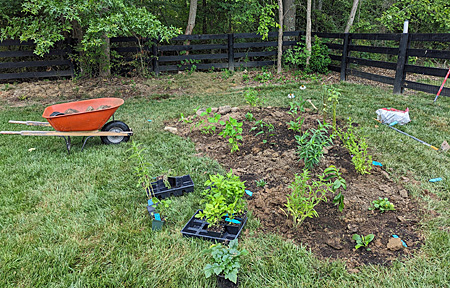Volume 28 Issue 4, Fall 2023
by BJ Lecrone, Audubon at Home Ambassador and Virginia Master Naturalist
Willowsford is a residential community in Ashburn, conceived and managed by the Willowsford Conservancy, that pairs neighborhood housing with functioning ecosystem services and people-oriented agriculture. The conservancy manages more than 2,000 acres of diverse wildlife habitat, including woodlands, ponds, streams, and a native plant demonstration garden. The Willowsford community has exclusive access to these inspiring natural areas, and some residents are even replacing their builder-grade landscapes with carefully selected native plants that benefit wildlife.

The Gogats family has incorporated many native plants into new and existing garden beds, and local wildlife is responding. Photo by Alicia Gogats.
We are excited to spotlight a family that recently decided to do just that. Brad and Alicia Gogats moved into their Willowsford dream house three years ago. Their brand-new home was landscaped by the builder with a bountiful supply of non-native plants, including Knock Out roses, daylilies, and nandinas.
Brad and Alicia dug the first wildlife-centered bed in their backyard in June. They included a few landscaper favorites along with natives that provide food for insects in the summer. As the bees started showing up, they noticed a difference and thought, “Let’s do more.” A few weeks later they removed some turfgrass and created beds at the property’s rear edge. Threadleaf Bluestar Amsonia, Oakleaf Hydrangea, and many other Audubon at Home-recommended native plants quickly adapted to their newly created beds.
The next step was a bit more difficult but resulted in an incredible increase in wildlife presence at the edge of the yard, where it bordered woodland. The Gogats used the iNaturalist app to identify plants in this area and discovered the usual invasive bullies: Oriental Bittersweet, Japanese Honeysuckle, and Autumn Olive. Brad, Alicia, and their kids immediately rolled up their sleeves and began the hard work of pulling, cutting, and removing the offenders, which made room for any existing natives to grow. They widened beds to plant their own Pawpaw tree. As more birds showed up to forage and give thanks, they couldn’t resist shopping at Wild Birds Unlimited, where the kids chose feeders of all sorts and sizes. Now they have quite the assortment of birds flying from the tree-and shrub-filled edgeline to feeders in multiple locations. That includes hummingbirds performing acrobatic flights around the property while they enjoy their own feeders, nectar-rich flowers such as Cardinal Flower, and water sources. The kids watch closely to ensure the feeders are kept full.

A Zebra Swallowtail butterfly visits Purple Coneflowers (a US native) in the Gogats family’s new garden. Photo by Brad Gogats.
The best part of the hard work is that this family enjoys additional peace and delight that wasn’t there before. Walking in the morning with coffee cups in hand, they watch their native plant and pollinator habitat in action. Later in the day, they kick back on the patio to observe the variety of birds enjoying the feeders. Taking a look at what their Wyze cameras capture during the day and night can bring the thrill of seeing the wildlife attracted to their backyard, like the fox that shows up to hunt the property. Their landscape is providing valuable habitat for wildlife, but also a calmer and more enjoyable world for their family.
But wait, there’s more! In early September, Brad and Alicia removed all the non-native plants in their front yard and replanted with natives. The beds that used to contain Knock Out roses, nandina, and daylilies are now a pollinator paradise.

A fox strolls through the back garden during a nighttime hunt, captured by the Gogats’ Wyze camera.
Brad and Alicia have documented on their property 10 wildlife indicator species that signal a healthy habitat. They have committed to reduced pesticide use, and provided water sources and a broad selection of native plants. These measures qualify their property for Wildlife Sanctuary certification through the Audubon at Home program. It’s a joy to see clients catch the spirit that comes along with the critters and pollinators that just show up when non-natives are removed and replaced with native plants. The Audubon at Home program will continue to provide resources and recommendations to help this family on their nature journey.
Too often we hear that HOAs discourage this type of change. It’s encouraging to know that Willowsford welcomes residents’ efforts to establish thriving wildlife habitats. As Alicia said, “We learned that change doesn’t have to occur on a grand scale, but small improvements can make a big difference.”

